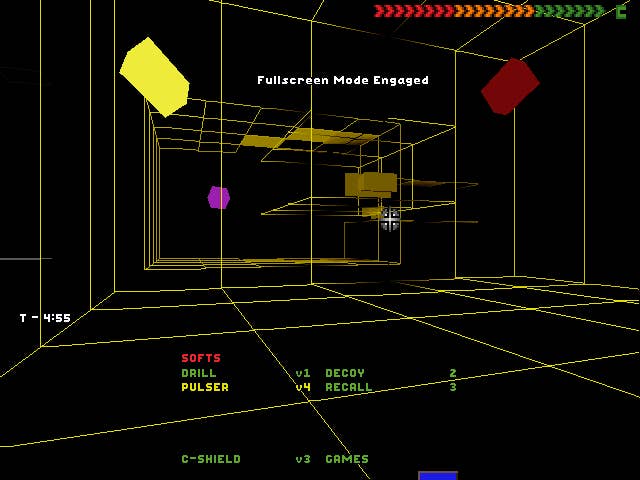Daily Classic: System Shock, a Study in Parallel Evolution
A pioneering shooter who beginnings well predated Doom's twitchy success.
This article first appeared on USgamer, a partner publication of VG247. Some content, such as this article, has been migrated to VG247 for posterity after USgamer's closure - but it has not been edited or further vetted by the VG247 team.
This week's Daily Classics features center on first-person shooters from 1994 and the evolution we saw in the genre 20 years ago following the colossal success of Doom. When id unleashed Doom upon the world through that poor, overburdened FTP late in 1993, one of gaming's most popular video game genres truly came into its own.
But it's important to remember that, influential as it was, Doom was by no means the world's first FPS. Spectre VR, for example, was the third entry in a series that began in 1991and riffed on an arcade title from 1980. Bethesda created a 3D open-world first-person action game based on the Terminator back in 1990. Few early first-person games, however, offered the depth and quality of content as Origin Systems' Ultima Underworld.

In a way, Ultima Underworld represented a back-to-the-roots take on the Ultima games, which in their earliest days featured first-person dungeon exploration through simple 3D wireframe graphics. Underworld, however, featured top-of-the-line visuals upon its debut in 1992, and it abandoned Ultima's traditional combat system to maintain a consistent sort of immersion; players battled monsters in real time from the same point of view through which they explored the underworld. Its unique combination of first-person action, role-playing depth, and high fantasy aesthetics had a tremendous influence on the likes of Elder Scrolls: Arena and even the id-published own Heretic.
And then there was System Shock. Though not a direct sequel to the Ultima Underworld games, System Shock is arguably that series' truest successor. Created by key Underworld personnel (including producer Warren Spector and programmer Doug Church), System Shock recast the fundamental play style of Underworld in a science fiction setting. With the transition away from dreary fantasy into austere future, the action changed in turn as well, becoming slightly faster. Still, System Shock didn't abandon its RPG roots; it retained concepts like inventory, character upgrades, and most of all a heavy emphasis on narrative. Different weapons worked more effectively against specific enemies. And many upgrades and recovery items carried detrimental side effects, forcing players to balance their desire for raw power with the need to avoid stacking up too many disadvantages.

What the change in setting did bring, however, was the freedom to explore new concepts. No longer beholden to goblin-packed caverns, System Shock developers Looking Glass Studios crafted a sophisticated story heavily inspired by William Gibson's Neuromancer; players controlled an anonymous hacker thrust into conflict with an unhinged A.I., and the cat-and-mouse relationship between the hacker and the SHODAN machine intelligence that unfolded throughout the adventure provided the plot that drove the action. Like Neuromancer's Case, the player's hacker possessed a number of neural implants grafted to his body; these not only provided the opportunity to improve and customize the protagonist's skills without resorting to a standard RPG leveling system, they also gave him access to a separate mode called Cyberspace... which, again, came straight from Neuromancer.
With all of these features combined into a single creation, System Shock straddled the line between shooter, RPG, and graphical adventure. Besides Ultima Underworld, its closest antecedent was Bungie's 1993 first-person adventure Pathways Into Darkness, which featured a similar style of play (including "levels" that could be revisited in a free-form world) and also revealed its story through passive text dumps at key locations rather than interaction with living beings. Much like its spiritual descendent BioShock, System Shock saw the protagonist completely isolated from other living creatures (except, of course, the ones that wanted to kill him). The plot unfolded through notes left about the space station and computer terminals where SHODAN would rant at you, and any creatures you encountered in the course of the adventure had the singular goal of destroying you.

This delicate balance of genre influences was all well and good, but what really brought the whole of System Shock together were its top-notch production values. Its true 3D world allowed for greater immersion than Doom's fake-perspective engine; players could look in all directions without the visuals distorting or breaking apart, whereas competing game engines at the time were forced to limit vertical head tracking in order to preserve their illusion of 3D. The dynamic music changed according to the player's current situation, allowing for seamless shifts in mood amidst free exploration of the space station.
Doom may have had the wider influence, but System Shock commands an impressive legacy in its own right. Its creators went on to design similarly dense and thoughtful shooters such as Deus Ex and BioShock, and its core customization mechanics have become integral components of the FPS genre – even in games that actively try to be as un-game-like as possible, such as Call of Duty. It represents a different branch of game design evolution, one that's crossbred into the lineage of pure action shooters, but whose legacy remains distinct.
